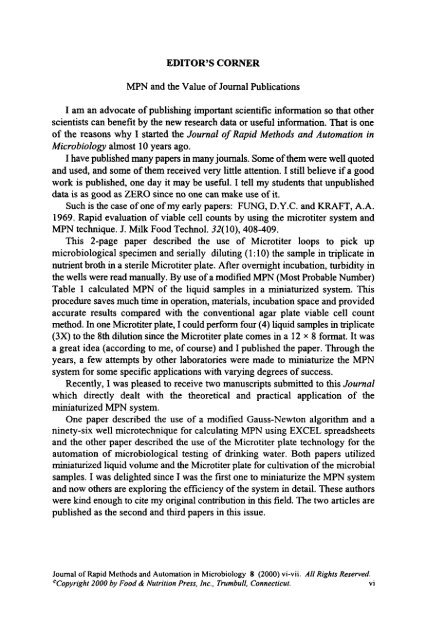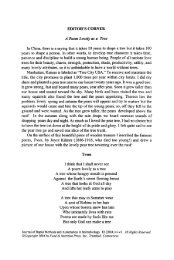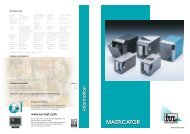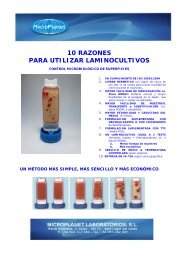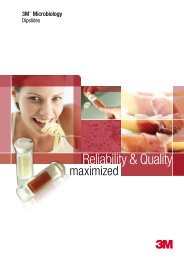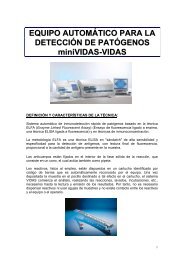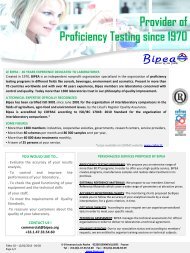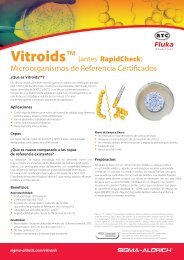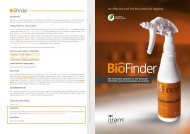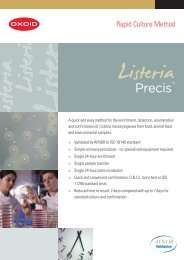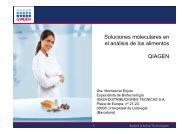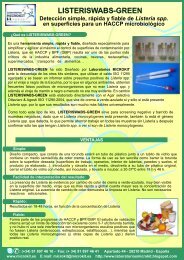EDITOR'S CORNER MPN and the Value of Journal Publications I ...
EDITOR'S CORNER MPN and the Value of Journal Publications I ...
EDITOR'S CORNER MPN and the Value of Journal Publications I ...
Create successful ePaper yourself
Turn your PDF publications into a flip-book with our unique Google optimized e-Paper software.
<strong>EDITOR'S</strong> <strong>CORNER</strong><br />
<strong>MPN</strong> <strong>and</strong> <strong>the</strong> <strong>Value</strong> <strong>of</strong> <strong>Journal</strong> <strong>Publications</strong><br />
I am an advocate <strong>of</strong> publishing important scientific information so that o<strong>the</strong>r<br />
scientists can benefit by <strong>the</strong> new research data or useful information. That is one<br />
<strong>of</strong> <strong>the</strong> reasons why I started <strong>the</strong> <strong>Journal</strong> <strong>of</strong> Rapid Methods <strong>and</strong> Automation in<br />
Microbiology almost 10 years ago.<br />
I have published many papers in many journals. Some <strong>of</strong> <strong>the</strong>m were well quoted<br />
<strong>and</strong> used, <strong>and</strong> some <strong>of</strong> <strong>the</strong>m received very little attention. I still believe if a good<br />
work is published, one day it may be useful. I tell my students that unpublished<br />
data is as good as ZERO since no one can make use <strong>of</strong> it.<br />
Such is <strong>the</strong> case <strong>of</strong> one <strong>of</strong> my early papers: FUNG, D.Y.C. <strong>and</strong> KRAFT, A.A.<br />
1969. Rapid evaluation <strong>of</strong> viable cell counts by using <strong>the</strong> microtiter system <strong>and</strong><br />
<strong>MPN</strong> technique. J. Milk Food Technol. 32( lo), 408-409.<br />
This 2-page paper described <strong>the</strong> use <strong>of</strong> Microtiter loops to pick up<br />
microbiological specimen <strong>and</strong> serially diluting (1 : 10) <strong>the</strong> sample in triplicate in<br />
nutrient broth in a sterile Microtiter plate. After overnight incubation, turbidity in<br />
<strong>the</strong> wells were read manually. By use <strong>of</strong> a modified <strong>MPN</strong> (Most Probable Number)<br />
Table 1 calculated <strong>MPN</strong> <strong>of</strong> <strong>the</strong> liquid samples in a miniaturized system. This<br />
procedure saves much time in operation, materials, incubation space <strong>and</strong> provided<br />
accurate results compared with <strong>the</strong> conventional agar plate viable cell count<br />
method. In one Microtiter plate, I could perform four (4) liquid samples in triplicate<br />
(3X) to <strong>the</strong> 8th dilution since <strong>the</strong> Microtiter plate comes in a 12 x 8 format. It was<br />
a great idea (according to me, <strong>of</strong> course) <strong>and</strong> I published <strong>the</strong> paper. Through <strong>the</strong><br />
years, a few attempts by o<strong>the</strong>r laboratories were made to miniaturize <strong>the</strong> <strong>MPN</strong><br />
system for some specific applications with varying degrees <strong>of</strong> success.<br />
Recently, I was pleased to receive two manuscripts submitted to this <strong>Journal</strong><br />
which directly dealt with <strong>the</strong> <strong>the</strong>oretical <strong>and</strong> practical application <strong>of</strong> <strong>the</strong><br />
miniaturized <strong>MPN</strong> system.<br />
One paper described <strong>the</strong> use <strong>of</strong> a modified Gauss-Newton algorithm <strong>and</strong> a<br />
ninety-six well microtechnique for calculating <strong>MPN</strong> using EXCEL spreadsheets<br />
<strong>and</strong> <strong>the</strong> o<strong>the</strong>r paper described <strong>the</strong> use <strong>of</strong> <strong>the</strong> Microtiter plate technology for <strong>the</strong><br />
automation <strong>of</strong> microbiological testing <strong>of</strong> drinking water. Both papers utilized<br />
miniaturized liquid volume <strong>and</strong> <strong>the</strong> Microtiter plate for cultivation <strong>of</strong> <strong>the</strong> microbial<br />
samples. I was delighted since I was <strong>the</strong> first one to miniaturize <strong>the</strong> <strong>MPN</strong> system<br />
<strong>and</strong> now o<strong>the</strong>rs are exploring <strong>the</strong> efficiency <strong>of</strong> <strong>the</strong> system in detail. These authors<br />
were kind enough to cite my original contribution in this field. The two articles are<br />
published as <strong>the</strong> second <strong>and</strong> third papers in this issue.<br />
<strong>Journal</strong> <strong>of</strong> Rapid Methods <strong>and</strong> Automation in Microbiology 8 (2000) vi-vii. AN Rights Reserved.<br />
'Copyright 2000 by Food & Nutrition Press, Inc.. Tiurnbull, Conneciicut. vi
EDITOR’S <strong>CORNER</strong> vii<br />
Several major improvements occurred in this field compared to my work in<br />
1969.<br />
(1) Automated instruments are now available in many laboratories to dispense<br />
liquid into <strong>the</strong> Microtiter plate. Automated dilution instruments are also available<br />
to facilitate rapid <strong>and</strong> aseptic dilutions <strong>of</strong> samples. These were not available in<br />
1969.<br />
(2) Automated readers <strong>of</strong> Microtiter wells are now common place to efficiently<br />
read turbidity, color, <strong>and</strong> fluorescence <strong>of</strong> <strong>the</strong> liquid in <strong>the</strong> wells for calculation <strong>of</strong><br />
<strong>MPN</strong>. Such instruments were not available in 1969.<br />
(3) Elegant ma<strong>the</strong>matic models, computer interpretations <strong>and</strong> analysis, <strong>and</strong><br />
printout <strong>of</strong> data are now available which I wuld not have envisioned back in 1969.<br />
I feel fortunate that I published my <strong>MPN</strong> paper as a graduate student in 1969.<br />
If I had not done that <strong>the</strong>se developments might not have occurred or that someone<br />
else could have come up with <strong>the</strong> same idea <strong>and</strong> received <strong>the</strong> credit! In conclusion,<br />
I highly recommend that scientists publish <strong>the</strong>ir work as soon as <strong>the</strong> task is done.<br />
You never know, 30 years later it may be <strong>of</strong> great importance to <strong>the</strong> field.<br />
DANIEL Y.C. FUNG<br />
Editor


